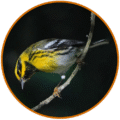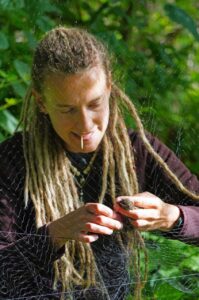
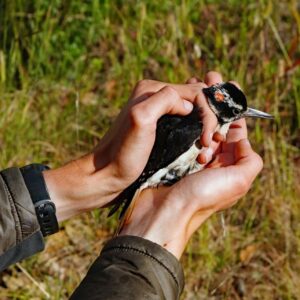
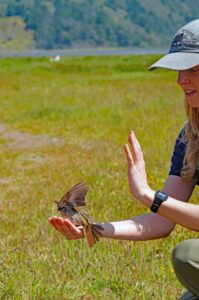
At the edge of the continent, where the Pacific Ocean meets the wooded ridges of Bolinas, morning fog clings to the coyote brush and thrush songs filter through the Douglas firs. Here, the apprentices have begun their morning circuit at the Palomarin Field station. The nets are set before first light, stretching like silk threads through coastal scrub. By midmorning, birds that have passed through the day’s nets have been gently banded, measured, recorded, and released: data points in an unbroken arc of observation stretching back over half a century.
On our visit, the first bird of the morning is a Wilson’s Warbler, its lemon-yellow belly flashing in the coastal sun. Gently, Fen Conway cups it in one hand while the other reaches for a band—aluminum, light as air, engraved with a number. At the banding table, Sarah Needles arrives from her morning loop with a Hairy Woodpecker, held carefully (the apprentices all agree: woodpeckers are the “stabbiest” birds to handle). For more than five decades, Point Blue Conservation Science has trained young scientists like Fen and Sarah through its intensive field apprenticeship program at the Palomarin. What begins for many as a few months of banding birds and recording data often becomes the foundation for a lifetime of conservation work.
Since the 1960s, more than a thousand apprentices have arrived at “Palo,” as it’s affectionately known—some from across the world, some local California communities. They come to learn the language of birds, of seasons, of hands-on-science. The data that they collect helps tell the broad, slow story of migrations, climate, and tightly woven ecosystems. The apprentices leave with sharpened eyes and, often, a new vision of their future.



Take Melissa Pitkin, who first came to Palomarin as a wide-eyed third grader on a school field trip. That formative experience lit a fire: “I distinctly remember walking the mist-netting trail in hopes of finding birds,” she said. She returned years later as a banding apprentice, waking early to check mist nets and record feather molt patterns. Over 25 years later, Pitkin has served in a variety of roles at Point Blue and now helps lead the organization as the new CEO, overseeing new generations of scientists and new visions for conservation work.
“It was an intense and awesome experience,” recalled Noah Strycker, now a globally known author and ornithologist, of his time as an intern. “To learn bird-monitoring and in-hand identification techniques from some of the best teachers in the world… One of the best things about mist-netting birds was to be able to touch them and see them up so close, however briefly.”
This is the quiet magic of the field station: it doesn’t just teach science—it teaches a way of seeing.
Amanda Gallinat, now a professor at Colby College, traces her academic path back to that small outpost on the coast. “Palo gave me a blueprint for what kind of researcher I want to be,” she wrote. “I learned how important it is to ground research questions in field observations, to seek out great people for collaboration, and to make time to go see beautiful things outside, identify them for fun, and then write limericks about them.” During her apprenticeship, Gallinat’s interest in phenology—how living things respond to seasonal change—flourished alongside field skills and the occasional papier-mâché project (a giant acorn woodpecker, crafted for Bolinas’s Fourth of July parade).
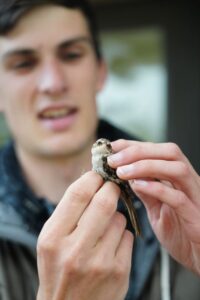
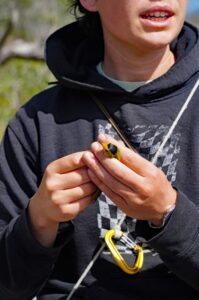
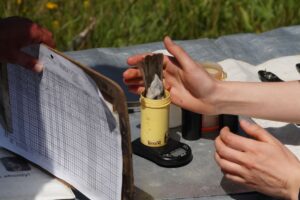
Some apprentices used Palomarin as a training ground for science leadership. Grant Ballard, now Point Blue’s Chief Science Officer, began at Palo as an intern. “We are driven by data,” he told The Press Democrat in 2019. “If the data don’t say anything, we don’t say anything.” That ethos—curiosity grounded in evidence—has shaped Point Blue’s work, from hands-on field research to building an international database that helps bird biologists speak the same language across borders.
Others carry the field station’s lessons into education, museum curation, or art. Keith Hansen has become a celebrated artist and author, continuing to monitor birds from his art studio window in Bolinas (he has documented 231 birds from this one 16 X 23-foot location!) Moe Flannery, now with the California Academy of Sciences, began her journey with a winter banding position at Palo. “I am forever grateful for the opportunity,” she wrote. “Working at Palo taught me how to be an accurate scientist and, more importantly, how to share that science with visitors in an engaging way. I would not be where I am today without all the experiences that I had at Palo.”
That spirit of mentorship—learning science and learning to share it—is embedded in every season’s cohort. Apprentices learn from staff biologists, from one another, and from the land itself. Some go on to careers in academia, others in environmental policy or art. All carry with them a certain way of seeing the world, attuned to detail, guided by data, and shaped by wonder.
Former apprentices may return with new titles (professor, curator, program director) but the names of the birds that were their first teachers remain the same: Swainson’s Thrush, Wilson’s Warbler, Pacific-slope Flycatcher.
In the eyes of many, the birds are just passing through. But at Palo, they’re guides—showing young scientists how to watch, how to record, how to ask better questions. And as those apprentices fly on to new places, the station remains: weathered wood buildings, a communal kitchen, nets that catch the morning light.
